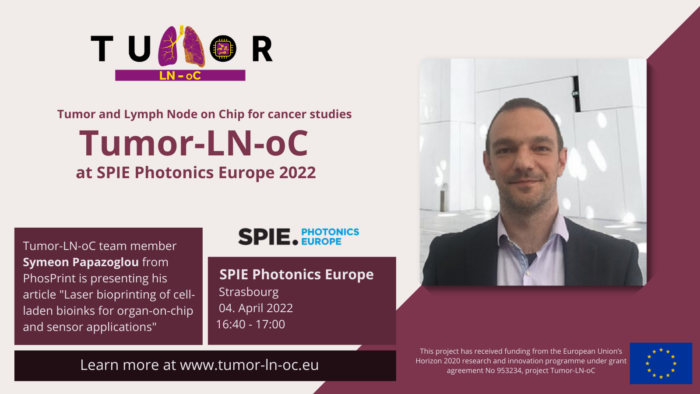Tumor-LN-oC at SPIE Photonics Europe 04.04.22
March 28, 2022Tumor-LN-oC team member Symeon Papazoglou from PhosPrint is presenting his article “Laser bioprinting of cell-laden bioinks for organ-on-chip and sensor applications” at SPIE Photonics Europe in Strasbourg.
Visit the SPIE website for more information about the presentation: https://spie.org/photonics-europe/presentation/Laser-bioprinting-of-cell-laden-bioinks-for-organ-on-chip/12135-10?enableBackToBrowse=true
Come meet us in Strasbourg on 4 April 2022 at 16:40!

Abstract of Paper
Bioprinting is a rapidly expanding additive manufacturing process, in which biomaterials like cells, hydrogels and extracellular matrix components are combined for the development of tissue-like complex structures, able to imitate native tissue functions. Due to the imperfection of current 2D models to precisely recapitulate tissue and cell functions, while taking also into account the effort to end animal use for research and testing, bioprinting is expected to be a key technology for addressing these issues. Main bioprinting techniques include extrusion, inkjet, and laser printing, where laser bioprinting based on the Laser Induced Forward Transfer technique in particular, offers the highest degree of spatial resolution (minimum feature of <10 μm) and post-printing cell viability. Most importantly, the high spatial resolution of laser printing technology, allows the precise and topologically defined laser printing of cells and cell-laden bioinks with printing speeds that can reach up to 4 m/s. In this study, we present our results on the transfer, using a dual laser beam configuration, of cell-laden bioinks within compartmentalized chambers of microfluidic chips, which are designed to serve as Organ-on-Chip devices for cancer metastasis and migration studies. Cell-laden bioinks in this study comprise different hydrogels, cell lines and bioink formulations and printing is performed on polyethylene terephthalate membranes either bare or hydrogel-coated to study cell adhesion and growth. A comparative study based on different hydrogels that serve as membrane coatings is performed to investigate which hydrogel or hydrogel combination promotes cell growth for each cell line. Single pulses generated from a sub-nanosecond, solid-state micro-laser operating at 532 nm are employed to transfer discrete cell-containing and/or hydrogel-containing droplets, which when printed in specific patterns they, over time, form organoids. This study highlights the unique advantages of digital laser bioprinting for Organ on Chip devices employed in cancer metastasis and healthcare applications in general.